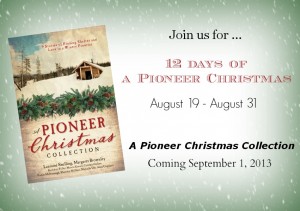12 Days of Pioneer Christmas: Uncommon Romance
 A Pioneer Christmas is the third
inspirational romance collection for which I’ve written a story. As is my
custom, I’ve read the stories written by my co-writers to get a feel for the
book. This beautiful fat book with nine tales feels just a little different from
your average Christmas romance novella.
A Pioneer Christmas is the third
inspirational romance collection for which I’ve written a story. As is my
custom, I’ve read the stories written by my co-writers to get a feel for the
book. This beautiful fat book with nine tales feels just a little different from
your average Christmas romance novella.The romance genre has specific elements that make it a romance: the point of view alternates between the hero and the heroine; the couple traditionally meet in the first chapter and don’t like each other; the stories end with a wedding.
Wikipedia notes: “novels in this genre place their primary focus on the relationship and romantic love between two people, and must have an “emotionally satisfying and optimistic ending.”
Most people translate that into a shorthand: boy meets girl; girl doesn’t like boy; boy loses girl; girl recognizes the boy’s finer qualities (perhaps he saves her); they marry and live happily ever after
But in A Pioneer Christmas, several writers–including me– tweaked the genre for a different angle on pioneer romance. I found them delightfully satisfying and a bit bemusing, wondering more than once, “how is this one going to end?”
Fully a third of these stories begin with a married couple–the romance is young and passionate, but the marriage already has been consummated.
So, where’s the romance in that?

I’m not giving away any spoilers . . .
It’s helpful to remember that life on the prairie was difficult and widow and widowerhood was a frequent occurrance. Marriages sometimes had to be made for convenience and “falling in love,” often was not practical when stock needed to be tended.
Cynthia Hickey’s A Christmas Castle is upfront about marital challenges between virtual strangers: her heroine is a mail order bride. Or, in this case, a mail order widow upon arrival in a small Arizona ranch town riven with controversy.
She takes to her inheritance with dash and aplomb, not to mention instant motherhood. She displays the deering-do necessary to survive, particularly when the neighbors are out to get you.
The Christmas Angel by Lauraine Snelling features an anxious pregnant woman whose husband is long overdue from town with the necessary supplies. What will happen to her out on that prairie they’ve fought so hard to “own up” if he does not return?
Her cheerful example in the face of tragedy, a determination not to give in to despair, resonated with me and I marveled at her strength.
Anna Urquhart’s A Silent Night begins with a young couple fully in love but facing a voyage across the Atlantic to a new life. When her husband goes missing with blood left on the ground, the heroine is forced to consider the unthinkable: marriage to an older neighbor.
But how else is she to survive in a half-built cabin with a small child to protect?
The Gold Rush Christmas displays tension between the heroine and the would-be hero–even though he doesn’t appear until chapter two. And what’s the deal with her brother seeming to like the guy better than his sister?
Even Margaret Brownley’s story A Pony Express Christmas features an unusual twist: the hero is rescued from certain death by the matter-of-fact heroine.
You can read more conventional genre challenges in Vickie McDonough’s Buckskin Bride; Shannon McNear’s Defending Truth; Kathleen Fuller’s The Calling; and Marcia Gruver’s The Badlands Christmas.
Christmas, of course, is featured in each story and most include at least a promise of mariage to come, My take away, though, was honest admiration for characters who overcame their circumstance to make a –mostly–realistic life in harsh surroundings.
A Pioneer Christmas Collection is an unusual and satisfying read–perfect for the winter when the snow is howling, the rain pouring, or the animals just in need of a little tending. And each one provides a complete and interesting night’s read.
But I admit–I’m biased!
What do you look for in a good romance?






